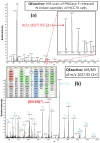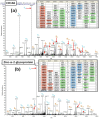Overcoming challenges and opening new opportunities in glycoproteomics
- PMID: 24790834
- PMCID: PMC4002168
- DOI: 10.3390/biom3020270
Overcoming challenges and opening new opportunities in glycoproteomics
Abstract
Glycoproteomics has emerged as a prime area of interest within the field of proteomics because glycoproteins have been shown to function as biomarkers for disease and as promising therapeutic targets. A significant challenge in the study of glycoproteins is the fact that they are expressed in relatively low abundance in cells. In response, various enrichment methods have been developed to improve the detection of glycoproteins. One such method involves their capture via oxidation of their glycan chains and covalent attachment with hydrazide resins which, when catalyzed by PNGase F, release N-linked glycans and convert the glycosite Asn to Asp; this conversion is identifiable with LC/ESI-MS/MS as a corresponding increase of 0.984 Da in molecular weight. The present study builds on this body of work, providing evidence of three additional strategies that improve glycoprotein identification: (1) use of a high resolution mass spectrometer-the Q Exactive MS-which delivers 2-3 times more glycoprotein identifications than a low resolution MS; (2) optimization of instrument settings and database search parameters to reduce misidentification of N-linked glycopeptides to ~1 percent; and (3) labeling glycopeptides with (18)O during PNGase F treatment to locate N-linked glycosites within peptides containing multiple N-linked sequons.
Keywords: 18O labeling; N-linked glycosites; Orbitrap; deamidation; glycoproteomics; hydrazide-modified magnetic beads; tandem mass spectrometry.
Figures






References
Grants and funding
LinkOut - more resources
Full Text Sources
Other Literature Sources
